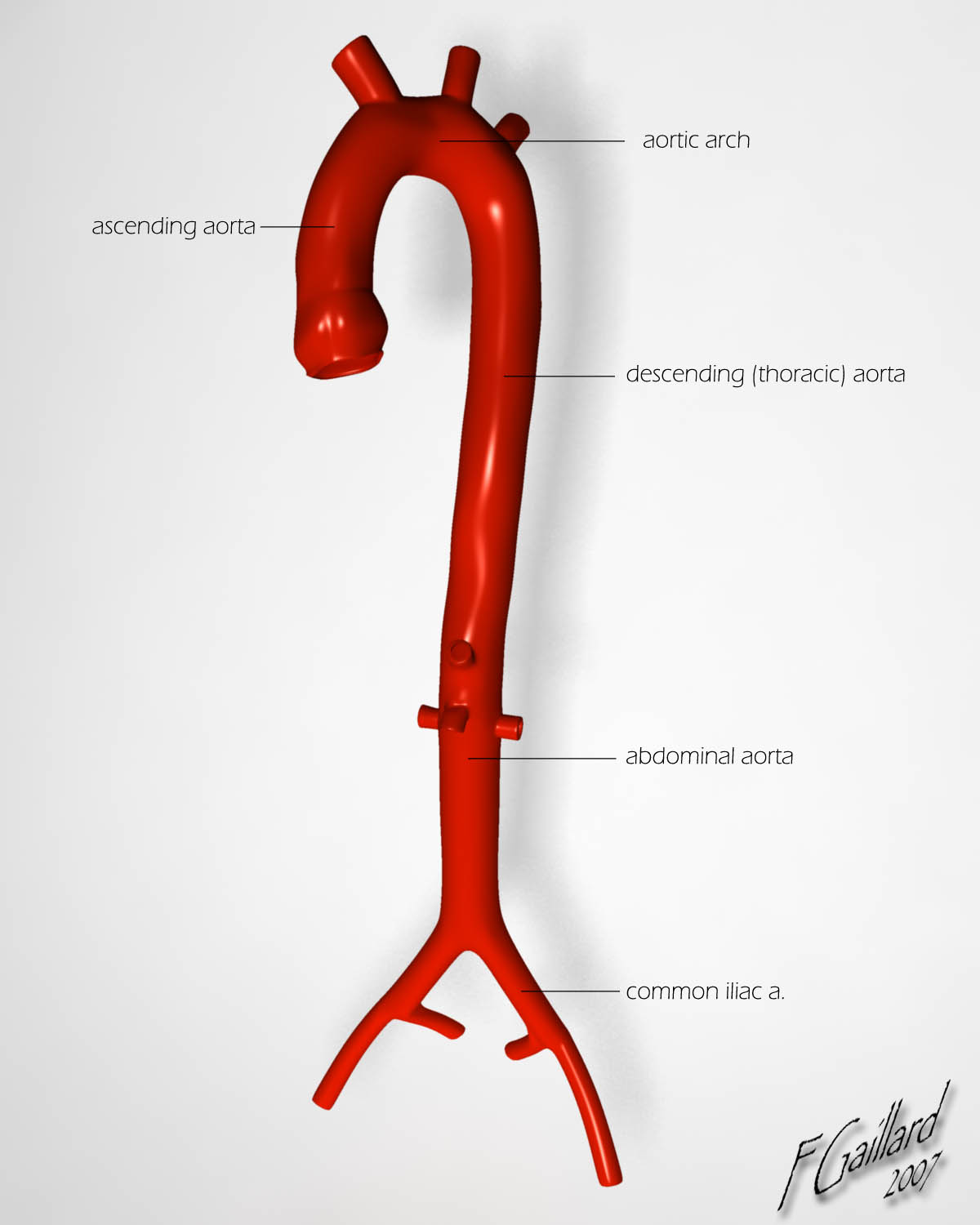Aorta
|
WikiDoc Resources for Aorta |
|
Articles |
|---|
|
Media |
|
Evidence Based Medicine |
|
Clinical Trials |
|
Ongoing Trials on Aorta at Clinical Trials.gov Clinical Trials on Aorta at Google
|
|
Guidelines / Policies / Govt |
|
US National Guidelines Clearinghouse on Aorta
|
|
Books |
|
News |
|
Commentary |
|
Definitions |
|
Patient Resources / Community |
|
Directions to Hospitals Treating Aorta Risk calculators and risk factors for Aorta
|
|
Healthcare Provider Resources |
|
Continuing Medical Education (CME) |
|
International |
|
|
|
Business |
|
Experimental / Informatics |
Editor-In-Chief: C. Michael Gibson, M.S., M.D. [1]
Associate Editor-In-Chief: Cafer Zorkun, M.D., Ph.D. [2]
The aorta (generally pronounced eɪˈɔːtə or "ay-orta") is the largest artery in the human body, originating from the left ventricle of the heart and bringing oxygenated blood to all parts of the body in the systemic circulation.
The course of the aorta
The aorta is usually divided into five segments/sections [1] [2] [3] [4] :
- Ascending aorta — the section between the heart and the arch of aorta
- Arch of aorta — the peak part that looks somewhat like an inverted "U"
- Descending aorta — the section from the arch of aorta to the point where it divides into the common iliac arteries
- Thoracic aorta — the half of the descending aorta above the diaphragm
- Abdominal aorta — the half of the descending aorta below the diaphragm
Features
The aorta is an elastic artery, and as such is quite distensible. When the left ventricle contracts to force blood into the aorta, the aorta expands. This stretching gives the potential energy that will help maintain blood pressure during diastole, as during this time the aorta contracts passively.
Diseases/pathology
- Aneurysm of sinus of Valsalva
- Aortic aneurysm - myotic, bacterial (e.g. syphilis), senile, genetic, associated with valvular heart disease
- Aortic coarctation - pre-ductal, post-ductal
- Atherosclerosis
- Marfan syndrome
- Trauma, such as traumatic aortic rupture, most often thoracic and distal to the left subclavian artery[5] and frequently quickly fatal[6]
References
- ↑ Tortora, Gerard J: "Principles of Human W. & Karen A. Koos: Human Anatomy, second edition, page 479. Wm. C. Brown Publishing, 1994 (ISBN 0-697-12252-2)
- ↑ De Graaff, Van: "Human Anatomy, fifth edition", pages 548-549. WCB McGraw-Hill, 1998 (ISBN 0-697-28413-1)
- ↑ Last's Anatomy - 10th Edition - Chummy S Sinnatamby
- ↑ Clemete's Anatomy - Regional Atlas of the Human Body - 3rd Edition
- ↑ Samett EJ. http://www.emedicine.com/radio/topic44.htm Aorta, Trauma. eMedicine.com. Accessed on: April 24, 2007.
- ↑ "Aortic Trauma in Scotland - A Population Based Study". European Journal of Vascular and Endovascular Surgery. 32 (6): 686–689. 2006. PMID 16750920. April 24, 2007
External links
- Template:GraySubject - Descending aorta
- Template:GraySubject - Abdominal aorta
- Cleveland Clinic Webchat - Aorta Surgery Webchat with Dr. Lars Svensson
Template:Arteries of chest Template:Arteries of abdomen
ar:الشريان الأبهر
ast:Aorta
bg:Аорта
ca:Aorta
da:Aorta
de:Aorta
el:Αορτή
eo:Aorto
eu:Aorta
ko:대동맥
hr:Aorta
id:Aorta
it:Aorta
he:אב העורקים
la:Aorta
lt:Aorta
hu:Aorta
ms:Aorta
nl:Aorta
no:Aorta
nn:Livpulsåre
nds:Aorta
sq:Aorta
sk:Srdcovnica
sr:Аорта
fi:Aortta
sv:Aorta
uk:Аорта
